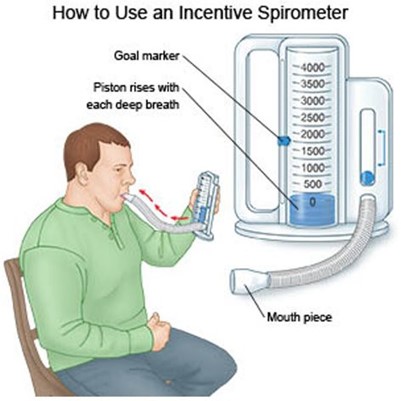A nurse is teaching a client about the use of an incentive spirometer.
Which of the following instructions should the nurse include in the teaching?
Exhale slowly through pursed lips.
Hold breaths for about 3 to 5 seconds before exhaling.
Place hands on the upper abdomen during inhalation.
Position the mouthpiece.5 cm (1 in) from the mouth.
The Correct Answer is B

After inhaling deeply using an incentive spirometer, you should hold your breath for 3 to 5 seconds before exhaling.
Choice A is wrong because exhaling slowly through pursed lips is not an instruction for using an incentive spirometer.
Choice C is wrong because placing hands on the upper abdomen during inhalation is not an instruction for using an incentive spirometer.
Choice D is wrong because positioning the mouthpiece.5 cm (1 in) from the mouth is not an instruction for using an incentive spirometer.
Nursing Test Bank
Naxlex Comprehensive Predictor Exams
Related Questions
Correct Answer is C
Explanation
“You should expect a warm sensation after the injection of the contrast dye during the procedure.” During cardiac catheterization, a contrast dye is injected into the body to highlight blood flow through the arteries and show blockages in the blood vessels that lead to the heart.
This can cause a warm sensation.
Choice A is incorrect because usually, patients are awake during cardiac catheterization but are given medications to help them relax.
Choice B is incorrect because recovery time for a cardiac catheterization is quick.
Choice D is incorrect because there is no information found to support this statement.
Correct Answer is C
Explanation
“Weight loss of.8 kg (4 Ib) in the past 24 hr.” Furosemide is a diuretic that decreases the pressure caused by excess fluid in the heart and lungs.
A weight loss of.8 kg (4 Ib) in the past 24 hr indicates that excess fluid is being removed from the body, which is a sign that the medication is effective.
Choice A is incorrect because adventitious breath sounds are a symptom of pulmonary edema, not an indication that the medication is effective.
Choice B is incorrect because furosemide has direct vasodilatory outcomes 2, which would decrease blood pressure, not elevate it.
Choice D is incorrect because there is no information found to support this statement.
Whether you are a student looking to ace your exams or a practicing nurse seeking to enhance your expertise , our nursing education contents will empower you with the confidence and competence to make a difference in the lives of patients and become a respected leader in the healthcare field.
Visit Naxlex, invest in your future and unlock endless possibilities with our unparalleled nursing education contents today
Report Wrong Answer on the Current Question
Do you disagree with the answer? If yes, what is your expected answer? Explain.
Kindly be descriptive with the issue you are facing.
